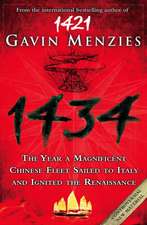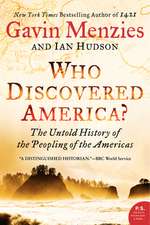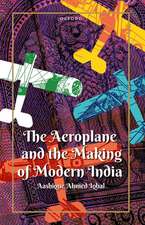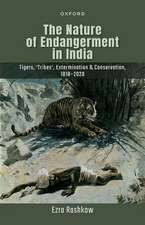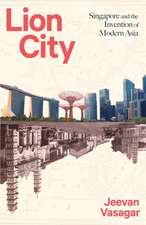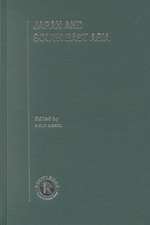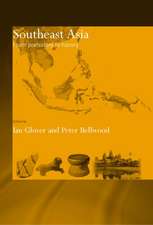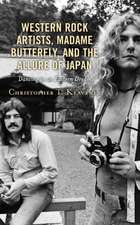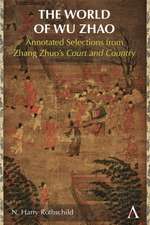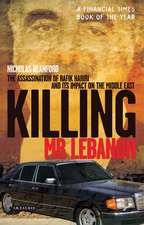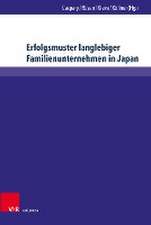1421. The Year China Discovered the World
Autor Gavin Menziesen Limba Engleză Paperback – oct 2003
Preț: 64.84 lei
Nou
12.41€ • 13.47$ • 10.42£
Carte în stoc
Livrare din stoc 12 martie
Specificații
ISBN-10: 0553815229
Pagini: 649
Dimensiuni: 129 x 199 x 60 mm
Greutate: 0.56 kg
Editura: Transworld Publishers Ltd
Colecția Bantam
Locul publicării:United Kingdom
Notă biografică
Extras
The Voyage of Zhou Wen
11
SATAN'S ISLAND
In October 1421, when the fleets of hong bao and zhou Man had sailed south-west from the entrance to the Caribbean towards the coast of South America, they had left the fleet of Admiral Zhou Wen taking a course to the north-west following the northern branch of the equatorial current. I already knew that this fleet must have later reached the Azores, at the latitude of Beijing, for the islands appear on the Kangnido map, drawn before the first Europeans discovered those islands. My task was now to find where Zhou Wen had sailed between those two landfalls.
When Admiral Zhou Wen reached the Cape Verde Islands he had already sailed across a substantial part of the globe and must have known that the mysterious land of Fusang lay to the west of him. By the time of the great cartographer Chu Ssu Pen (1273-1337), the Chinese had made an accurate estimate of the distance from the Pacific to the Atlantic, but how far to the west Zhou Wen thought Fusang lay would depend on how far he considered he had already sailed. The Kangnido shows that, because of the effects of the ocean currents, the Chinese fleets had underestimated their voyage across the 'bulge' of Africa by a couple of thousand miles. As he lay at anchor at Santo Ant‹o in the Cape Verde Islands, Zhou Wen might well have assumed that Fusang lay four thousand rather than two thousand miles to the west of him, but that was still well within his range, without the need for fresh provisions or water en route.
North of the equator, the Atlantic is a vast oval-shaped wind and current system rotating clockwise day in, day out, throughout the year. British Admiralty sailing directions advise mariners on how to make use of these winds and currents: 'From Madeira the best track is to pass just west of, but in sight of, the Cape Verde Archipelago . . . from Cape Verde steer a direct course [for the Caribbean] . . . thereafter . . . the north equatorial current and south equatorial current converge, forming a broad band of current setting west. Average rates reach 2 knots.' From the Cape Verde Islands they carry the mariner due west to the Caribbean, then north-west towards Florida and north up the American seaboard before taking him clockwise to the east, where the current becomes the Gulf Stream carrying the mariner across the Atlantic to the Azores, a thousand miles west of Portugal. It then hooks southwards, back once again to the Cape Verde Islands. The commander of a ship with sufficient provisions can hoist sail off the Cape Verde Islands and sit back and do nothing. Provided he is not capsized by a storm, a common occurrence in the North Atlantic, he will eventually end up more or less where he started.
The westerly current from the Cape Verde Islands reaches its strongest flow when approaching the Caribbean at the latitude of the island of Dominica. As a result, explorer after explorer down the centuries - Columbus on his second voyage, the Spanish explorers Rodrigo de Bastida and Juan de la Cosa in the early years of the sixteenth century, the French and English fleets during the Napoleonic Wars - has entered the Caribbean through the passage between Dominica and Guadeloupe. I would put the likelihood as high as 80 per cent that if, having replenished with fruit and fresh water, the Chinese had sailed from the Cape Verde Islands in October they would have been entering the Caribbean by early November.
The track of the junks of Admiral Zhou Wen's fleet through the Caribbean should logically have been the same as that of Columbus, for the winds and tides have remained unaltered from that day to this. Whatever the Chinese discovered should have been rediscovered by Columbus seventy years later. By examining Columbus's diaries of his second voyage, I should be able to reconstruct the most likely track. If the Chinese had found any islands or land on their voyage across the North Atlantic, I could expect those discoveries to be recorded on charts drawn after they returned to China in 1423. Just as I had done for South America and Australia, I now began to search for a chart that, like the Piri Reis and Jean Rotz maps, appeared to depict lands Europeans had yet to discover.
In that era, Venice, the base of Fra Mauro, the Venetian cartographer working for the Portuguese government, led the West in mapmaking. As I expected, Venetian and Catalan charts (Catalonia was then part of the Kingdom of Aragon; the Catalans were redoubtable seafarers) drawn before 1423 disclosed nothing new in the western Atlantic, but a chart dated 1424 and signed by the Venetian cartographer Zuane Pizzigano was an entirely different matter. The Pizzigano chart was rediscovered some seventy years ago and in the early 1950s it was sold to the James Ford Bell Library at the University of Minnesota. Its authenticity and provenance have never been questioned and several books have been written about it by distinguished historians.
[The 1424 chart] is a document of capital importance to the history of geography. From the historical point of view, it is undoubtedly one of the most, if not the most, precious jewel yielded by the disclosure of the almost unknown treasures contained in the unique collection of early manuscripts assembled by Sir Thomas Phillips during the first three-quarters of the nineteenth century. The great importance of this chart lies in the fact that it is the first to represent a group of four islands in the western Atlantic, called Saya, Satanazes, Antilia and Ymana . . . there are many and good reasons for concluding that the Antilia group of four islands shown for the first time in the 1424 chart should be regarded as the earliest cartographic representation of any American lands.
This was high praise indeed. I made a close study of the chart (see Introduction). It is markedly different from its contemporaries. It is not centred on the Mediterranean, as earlier charts were, but looks westwards across the Atlantic, where two large islands, Antilia and Satanazes, hitherto unknown to Europeans, are depicted. Two smaller islands are also shown: Saya, a parabolic island to the south of Satanazes, and the box-shaped island of Ymana to the north of Antilia.
Other accounts of the era put the islands '700 large leagues' west of the Canaries, which would put them near the Bahamas, but no large islands are located there. Were the islands imaginary? Other chartmakers clearly believed they were genuine, for the group was subsequently represented on at least nineteen fifteenth-century maps and two globes, all of them drawn before Columbus set sail (see chapter 17). But as time went by, successive cartographers relocated the islands further and further to the south-west, until they ended up in the Netherlands Antilles.
The Portuguese names on the chart had made me presume that they were the original cartographers, but the names on the Piri Reis and the Jean Rotz charts were also in Portuguese and they could not possibly have been the discoverers of the Antarctic, Patagonia or Australia. Portuguese records in the Torre do Tombo, the National Archives of Portugal in Lisbon, state unequivocally that Henry the Navigator sent caravels to discover Antilia after he had received a similar but slightly later chart (the 1428 World Map discussed in chapter 4). Moreover, in 1424 the Portuguese simply did not have the capacity to survey the islands with such accuracy - for the carto-graphy of Antilia was amazingly good. I concluded that it could only have been the Chinese. However, I needed further proof that this was the case, and I found once again that the best way of tackling this puzzle was to put myself in the cartographers' shoes. When in submarines, we used to spend time in the Barents Sea photographing military installations. Part of our training was in periscope photography and the obscure art of constructing charts from near sea level. At the time I was working from about the same height as the cartographers of the Pizzigano chart, standing on the deck of a medieval ship.
As Zhou Wen's ships approached the Caribbean, they would have had warning some two days out that they would shortly sight land. Clouds, winds, weather and sea-bird types would all change, and finally, a few hours before the islands became visible, the crew would have begun to detect the soft, subtle smell of wet foliage. Because Columbus sailed through the Dominica Passage on a Sunday, he named the island to the south Dominica, the Spanish name for that day of the week; that to the north was named Marie-Galante after his flagship. He first landed at Marie-Galante but found little and pushed on northwards with the current, landing the next day at an island he named Guadeloupe in memory of his visit to a monastery of that name in Extremadura in Spain. Had they known, the monks might have raised objections to his choice of name, for the inhabitants of the island were Carib cannibals. Dr Chanca, a chronicler of Columbus's second voyage, recorded his men striding through the soft sand into the coconut groves where they found 'houses, about 30, built with logs or poles interwoven with branches and huge reeds and thatched . . . with palm . . . square and cottage like . . . For dishes [they use] calabashes [a gourd] . . . and, oh horrors!, human skulls for drinking vessels.' Only women were left in the villages; the native men had fled to the hills in terror at the sight of the sails of Columbus's fleet.
The stench of bodies horrified Columbus's men. 'Limbs of human bodies hung up in houses as if curing for provisions; the head of a youth so recently severed from the body that the blood was yet dripping from it, and parts of his body were roasting before the fire, along with savoury flesh of geese and parrots.' The natives used arrow-heads made from human bones, and in their attacks upon the neighbouring islands, these people capture as many of the women as they can, especially those who are young and beautiful, and keep them as concubines . . . they eat the children which they bear to them . . . Such of their male enemies as they can take alive they bring to their houses to make a feast of them, and those who are killed they devour at once. They say that man's flesh is so good, that there is nothing like it in the world . . . in one of the houses we found the neck of a man undergoing the process of cooking in a pot. When they take any boys prisoners, they dismember [castrate] them and make use of them until they grow up to manhood, and then when they wish to make a feast they kill and eat them, for they say that the flesh of boys and women is good to eat. Three of these boys came fleeing to us, thus mutilated.
Another contemporary writer noted that it was 'their custom to dismember the male children and young slaves, whom they capture and fatten like capons'.
To fifteenth-century eyes, the cannibalism Columbus encountered could easily have been seen as the work of the devil. Could that be the explanation of the name Satanazes - Satan's Island? Was this what the Chinese had found, and was Guadeloupe the Satanazes shown on the Pizzigano chart? If so, like Columbus seventy years later, the Chinese would have approached the island from the south-east on the prevailing wind and current.
I turned my attention to the island of Saya lying to the south-east of Satanazes on the Pizzigano chart. I could vividly picture the scene as the Chinese approached because I spent some time in the Caribbean in command of the submarine HMS Rorqual and had visited and photographed many of the islands. In many cases the mountains appear black, surrounded by green jungle. Heavy rainstorms occur without warning, blotting out the islands. Frequently, birds take flight just before the rains arrive, circling in flocks, shrieking with foreboding.
As soon as I consulted a modern map, I saw that Saya on the Pizzigano map corresponded to Les Saintes. It is approximately the same shape and lies in the same position relative to Guadeloupe as Saya to Satanazes. I assumed that Saya was indeed Les Saintes, Satanazes was Guadeloupe and, based on my calculations of their course and speed, that the Chinese had arrived off the islands in November 1421. Given the maximum height of Les Saintes (about a thousand feet) and the height of eye of a seaman on the deck of a Chinese junk, I estimated that they would have seen the island from twenty-five miles away, while still in the Dominica Passage. From that position they should also have seen the plateau island of Marie-Galante ten miles north of them and the mountainous Dominica ten miles to the south, yet neither was recorded on the chart. I made the obvious deduction that they had passed through the passage in darkness with no moon. When I checked the records, I discovered that the new moon occurred on 25 November 1421, so I took it that they had probably approached Les Saintes from the south-east around dawn, possibly on 26 November 1421.
Les Saintes is composed of two large islands, Terre de Basse and Terre de Haut, and three smaller ones, La Coche and Grand Ilet in the south, and Ilet a Cabrit in the north. The big islands are much higher than the smaller ones and, approached from the south-east, the lower Grand Ilet and La Coche would merge with the taller islands in the background and appear to form a single block of land. The south coast would appear as a single parabolic island, just as it is drawn on the Pizzigano chart. Knowing the height from which they had surveyed it - the deck level of a treasure ship Ð I could now make an estimate to within two miles of the location from where Saya was charted.
What else would the Chinese have seen from this position? Just what Columbus saw from the same spot seven decades later: 'Dawn reveals a most romantic landscape. A volcanic peak rises to an immense height, and cataracts pouring down its sides appear like water falling out of heaven . . . Flights of brightly coloured noisy parrots and other brilliant tropical birds are winging their way from one island to another and the wind of the land is laden with sweet odours.' The 'volcanic peak' is La Souffrière on Guadeloupe, eighteen miles to the north-west. La Souffrière is well inland, its peak frequently shrouded by clouds and heavy rain, and seven rivers pour down its eastern side, the most spectacular among them the 120-metre Karukera Falls. The Chinese junks would have been at sea for at least three weeks, and I am sure the chance to take on water would not have been spurned. They would have altered course for the cataracts.
I turned to the words con and ymana marked on Satanazes on the Pizzigano chart. My first attempt to solve the riddle of these names was to recruit an expert at crosswords, who came up with con as a shell, conical mountain or volcano Ð interesting, but not much help. Then Professor João Camilo dos Santos, an expert in medieval Portuguese attached to the Portuguese Embassy in London, translated these words for me as 'a volcano' (con) 'erupts there' (ymana). The description was highly significant. Transposing the location of these words on the Pizzigano chart onto the corresponding modern map placed them directly above the volcanoes of La Souffrière, La Citerne and L'Echelle. Had these volcanoes erupted in 1421? The Smithsonian Institution confirmed there were two eruptions of the three volcanoes between 1400 and 1440; the dates, calculated by radio carbon-dating, cannot be determined more precisely.10 There were no further eruptions from these volcanoes for another 250 years, and no eruptions of other volcanoes in the Caribbean during the whole of the fifteenth century.11 Since the Pizzigano chart can only have recorded an eruption of the volcanoes on southern Guadeloupe, I had first-hand evidence that a cartographer had been in the Caribbean no later than 1424, sixty-eight years before Columbus.
There are some anomalies in the map, but they are easily explicable when one retraces the route the ships must have taken. As the Chinese junks headed for the waterfalls on Guadeloupe, they would have had to sail closer and closer to Les Saintes, for all the time the current was pushing them westwards. As they passed the north-east tip of Les Saintes, the cartographer drew Baie du Marigot from half a mile away with the morning sun behind him. Because this bay was so close and so well lit, its size was somewhat exaggerated on the Pizzigano chart. As the junks neared land, the cartographer drew two further bays on the north coast of Saya. The third, Passe du Pain du Sucre, was drawn from a distance of seven miles, much further away than the first drawing, and it was now nearly noon (assuming their speed through the water was 4.8 knots) so the sun was in the cartographer's eyes. The combination of the position of the sun and the greater distance resulted in the third bay being drawn smaller than it should have been. To check that my conclusions were accurate, I showed the chart and my navigational workings to a fellow of the Royal Geographical Society, like myself a professional navigator. He was also convinced that Saya is Les Saintes; it is drawn precisely as it would have been seen from sea level when approaching from the south-east.
Having calculated the time of day at which the cartographer drew Les Saintes, I was able to estimate with some certainty that by noon the junks had landed in the Baie de Grande Anse on southern Guadeloupe. I could imagine them replenishing their fresh water supplies against a backdrop of white, purple and blue hibiscus and orchids ('the wind of the land is laden with sweet odours'). Cassava, peppers and yuccas were there for the taking. The sea is a kaleidoscope of fish, crabs bask on exposed coral and crayfish are abundant. I could visualize the mariners gambolling in the surf before they feasted, washed their clothes and stocked their ships with fruit. How delightful it must have been to swim in the warm water after being at sea for nearly a month. It used to be my practice when in command of HMS Rorqual to anchor off an inhabited bay and send the sailors ashore in the inflatable dinghies we carried. It always proved a popular excursion - a swim in the sea, followed by rum toddies and roast lobster.
In the eastern Caribbean, an offshore breeze usually springs up as the land cools in the early evening. The Chinese had landed on an exposed Atlantic shore and would have had to find a sheltered anchorage for the night. Two hours' sailing up the east coast would have brought them to a secluded anchorage between two coral islands in the southern part of Baie de Sainte Marie. My assumption was that the Chinese had landed, watered and anchored at precisely the same spot Columbus found seventy years later, and the French and English fleets centuries after that. At first sight that may seem an incredible proposition: why should ships of so many different nations over several centuries all end up at the same spot on a remote Caribbean island thousands of miles from home? They did so because they were all subject to the same natural forces.
The clockwise movement of current and winds drew Zhou Wen's fleet from the Cape Verde Islands to a latitude of 18¡N, where the equatorial currents converged to sweep them towards the Dominica Passage. As they entered the Caribbean, they were greeted by the magnificent volcano of La Souffrière in Guadeloupe with its cataracts of 'water falling out of heaven'. After watering on the Atlantic shore they needed to find shelter for the night; their anchorage was the nearest sheltered bay to the waterfalls. What they did not know was that this seeming paradise was 'satan's Island' - Satanazes - populated by cannibalistic Carib tribesmen. Guadeloupe was the Caribs' principal lair in the Caribbean, and they were skilful hunters of men, even when swimming. I spent a day in the British Library poring over Columbus's journal of his second voyage, which includes a description of a Carib attack on his fleet: 'These Caribs can fight about as well in water as in their canoe . . . the Spaniard dies in consequence.' After a Spanish sailor was killed, Columbus retaliated, and one of the Caribs had his belly slit open. His intestines were floating on the sea but, according to the Spanish accounts, the wounded Carib pushed them back inside his stomach with one hand while still firing arrows with the other.
On that gruesome note, I decided to end my researches for the day, but as I was making my way home that evening, it occurred to me that if the Chinese had landed on the island, they must have been attacked by the Caribs, just as Columbus was. Might there be some record or legacy of that landing? When I went back to the British Library to look again at the account of Columbus's second voyage, I made another extraordinary discovery as I read the following passage:
In one house they find what seems to be an iron pot . . . but here is a curiosity amongst savages - the stern post of a vessel. This must have drifted across the ocean from some civilized country. Perhaps, it is a part of the wreck of the Santa María. Now all stand aghast at the sight of a pile of human bones - probably the remains of many an unnatural repast.
Iron is not found on the Caribbean islands, nor indeed in Central America. The islanders used hollowed-out tree trunks for their boats, and they did not build them with stern posts, a sophisticated design. Stern posts had been in use in China since the first century ad; they did not reach Europe until the fourteenth century. Columbus's Santa María was wrecked off the north coast of Haiti, far away to the north-west of Guadeloupe, and the Gulf Stream would have carried flotsam from that wreck in precisely the opposite direction, north-west towards New England. I strongly suspected that the stern post came from a junk and the iron pot was one brought by the Chinese.
The Chinese would have put to sea to escape the Caribs, just as Columbus's fleet did. When safe in open water, three miles offshore, they would have rounded the southern tip of Guadeloupe and sailed before the wind up the west coast where they charted the headland of Vieux Habitants, the Bay of Anse de la Barque and the Bay of Deshaies. By the next evening they would have been sailing into the bay now known as Le Grand cul de sac Marin, and from there the cartographer drew what he could see of Grande Terre, the eastern island of Guadeloupe. It is a low-lying island, rising from fifty metres near the shore to no more than a hundred metres further inland. By this stage it would have been after dusk and Grande Terre would have appeared as no more than a hazy blur. The cartographer probably saw little of it, and never properly charted it. The Chinese then set sail once more before the wind and current, heading north-westwards across the Caribbean, probably making for 39°53'N, the latitude of modern Atlantic City, New Jersey, but also of Beijing, and another obvious reference point for the Chinese fleets to have chosen.
The cartographer had charted Les Saintes as he saw it from sea level, and placed it in the correct position relative to the western island of Guadeloupe, Basse Terre. He had accurately charted the east, south and west coasts of Basse Terre and Le Grand cul de sac Marin, placing the bays and rivers in their correct position, and had described the volcano La Souffrière and its sisters erupting. The chances of finding another island with erupting volcanoes, coupled with the same-shaped islands in the south and the bay in the north, are nil; there cannot be the slightest doubt that Satanazes is Guadeloupe (Basse Terre) and Saya is Les Saintes. Knowing Basse Terre's true size, I could adjust Satanazes' size to true, and as the Pizzigano chart gave Antilia's size and orientation in relation to Satanazes, I could also calculate the true size and orientation of Antilia. The Pizzigano chart also showed the relative positions of and distance between Satanazes and Antilia. To find Antilia, all I had to do was look for an island 135 kilometres long by 50 kilometres wide, aligned east-west, and lying some six hundred kilometres west-north-west of Guadeloupe, once again in the track of the prevailing current and wind.
I turned to a modern map to see if I could find a match for Antilia. The map revealed that Puerto Rico was in the correct position, had the true alignment and size, and lay directly on the route along which the wind and current would have swept the junks after they left Basse Terre. I compared the shape of Antilia on the Pizzigano chart with Puerto Rico. It was a very good match. I remember this still as a tremendous breakthrough. Overwhelmed by the importance of what I had discovered, I wandered off into the night in search of a celebratory drink.
I returned to the British Library early the next morning worried that tiredness and elation might have caused me to misread the evidence, but a comparison of a large-scale modern-day map of Puerto Rico with Antilia on the Pizzigano chart at once removed any residual uncertainties. There are striking similarities, particularly the overall shape and the bays of Guayanilla, San Juan and Mayaguez. Save for the south-east tip, Antilia and its harbours fitted Puerto Rico like a glove. The standard of the cartography was astounding, way beyond what the Portuguese could have achieved in 1424.
But the exaggerated south-east tip is easily explained. After leaving Guadeloupe, the winds and currents would have driven the Chinese to the north-west - the same track Columbus later followed - to a point sixty miles east of Puerto Rico. There, they would have sighted the menacing, anvil-shaped volcano El Yunque near the east coast and turned towards it for water. As they had done many times when surveying other islands during their voyages, the Chinese squadron would have been split in two, one sailing north and one south of Puerto Rico to chart both coasts simultaneously. Had they sighted the volcano in the evening, and if they were travelling at their average rate of 4.8 knots, they would have passed south of Vieques Island during the night. In the darkness they could not have seen that Vieques is a separate island, and accordingly drew it as part of the mainland of Antilia.14 The Pizzigano chart is also inscribed with the word ura - hurricane - near the east coast of Puerto Rico, a clear indication that Zhou Wen's fleet had been battered by a hurricane as it sailed away from the island. It would have been prudent of him to run before the storm on as few sails as possible so as to find anchor in a sheltered bay. This is consistent with the astonishingly precise cartography of the harbours on Puerto Rico's south, west and north coasts, drawn before Columbus had even been born.
The storm-damaged Chinese fleet had completed its survey of Puerto Rico, and I could imagine the junks unfurling their great sails at the tail end of the hurricane and setting sail for the north from Puerto Rico towards the latitude of Beijing. If that theory was correct, there should have been evidence of their voyage at that latitude. I was confident that the Chinese had sailed to the North Atlantic, for the stone erected by Zheng He at Liu-Chia-Chang in south China after this epic sixth voyage states 'the countries beyond the horizon and at the ends of the earth have all become subjects and the most western of the western or the most northern of the northern countries, however far away they may be'. From a Chinese perspective, the most northern of the northern countries and the most western of the western could only be referring to the Atlantic coasts of North America, but as ever, my problem was that the mandarins had destroyed all records of the treasure fleets. Once again, I had to look for clues in maps and charts of the northern hemisphere drawn before the first Europeans reached the Americas. I had to find a counterpart to the Pizzigano chart.
A world map popularly known as the Cantino came to my rescue. I had unearthed this extraordinary chart in the Biblioteca Estense in Modena, Italy, during my investigation into Zhou Man's visit to the Americas. It was drawn by an anonymous Portuguese cartographer and surreptitiously obtained by Alberto Cantino, the agent of the Duke Ercoli d'Este of Ferrara. The Cantino's provenance and credibility have never been questioned, and there is firm evidence for dating its acquisition to October 1502. The Chinese fleet had to sail before the wind and current; after leaving Puerto Rico, it would have been blown north-west towards Hispaniola and Cuba, and then through the Caribbean to the coast of Florida. The Cantino indeed reflects this, for it shows Hispaniola, Cuba and many other islands in the Caribbean and off Florida, but though it portrays the coast of Africa and the Indian Ocean and its archipelagos of islands with extraordinary accuracy, at first glance its depiction of the Caribbean appears woefully inadequate. Many of the islands seem to bear little relation to their present sizes and shapes, and I was baffled as to why it was so much in error.
I struggled to make sense of this for some considerable time; then, all at once, the answer came to me. Sea levels in 1421 were lower than they are today. Global warming has caused the polar ice to melt, causing sea levels to rise slowly but inexorably. The best estimate of the Proudman Oceanic Laboratory of Birkenhead in England is that they have risen over the past centuries by about one to two millimetres a year. Other reputable oceanographers put the rise a little higher, at an average of four millimetres a year. In the almost six centuries since 1421 it is safe to say that sea levels have risen between just under four and just under eight feet. For simplicity, I assumed that the overall rise had been one fathom, or six feet, roughly the midpoint of the range of estimates.
The British Admiralty charts of the Caribbean enabled me to visualize a completely new picture of the region. In 1421, vast areas that today are submerged would have been either above water or with rocks and reefs showing as breaking water and shoals. The banks and reefs of the Great Bahama Bank, stretching south of Andros Island towards Cuba, would in 1421 have been above water down to the latitude of the Tropic of Cancer, and the numerous sand ridges today marked as 'almost uncovered' on the modern chart would also have been above water. To the Chinese cartographers, everything from Cayo Guajava in the middle of Cuba's north coast as far as the latitude of Miami would have appeared as one large low-lying island, an extension of Cuba.
The prevailing wind and current would have driven the fleet along the north-east coast of Cuba, then due north to the east of Andros, up towards Grand Bahama. (Andros Island is a favourite submarine haunt, for there is a deep-water trench well to the east of the coast along which thousands of tons of nuclear submarine can hurtle at forty miles an hour in order to test its silence at depth and speed. Afterwards we would surface and relax under the palms on Andros beach, drinking Bacardi and Coke.) If the Chinese fleet had made the passage at night, they would never have seen any openings to the west and could only have drawn what appears on the Cantino. When I adjusted the modern chart to show everything to a depth of one fathom, many of the shallow lagoons between the Caribbean islands became dry land, and when I superimposed these adjustments onto the Cantino it was clear the Caribbean had been drawn with incredible accuracy, just as it would have appeared to mariners sailing through it on a following wind six centuries ago. Once again, it was extraordinarily good cartography.
The question I now had to face head on was whether this mapping could have been carried out by Columbus, who had reached the Caribbean in 1492, ten years before the Cantino was acquired. A number of learned professors have slightly different interpretations on the location of his first landfall in the Caribbean, varying between Samana Cay and Cat Island, and on where he first landed on the coast of Cuba. Columbus was a poor cartographer. On his first voyage his calculations of latitude were twenty degrees out - he believed he was somewhere in Nova Scotia - and his longitude was a thousand miles in error. Even if Columbus had a secret, and rather better, cartographer aboard who could have accurately drawn the Caribbean islands shown on the Cantino during all four of Columbus's voyages, that still left hundreds of thousands of square miles of ocean and islands shown on the Cantino that neither Columbus nor any other European explorer reached until twenty years after the chart was drawn. I concluded that the chart could not have been the product of any voyage by Columbus.
Could it have been drawn by an unknown Portuguese or Spanish expedition? One has to look at the overall picture of the lands covered by the Piri Reis and the Cantino together. By 1501, when the source chart was obtained from Columbus's sailor, the maker of the Piri Reis map could accurately depict South America and Antarctica. By the next year, 1502, the Cantino was showing Africa, the Indian Ocean and the Caribbean. To achieve the remarkable precision and wealth of detail of the Cantino and Piri Reis charts would have required at least thirty ships just to survey the Indian Ocean, let alone South America, Antarctica and Africa. Neither Portugal nor Spain could have sent so many huge fleets simultaneously to different quarters of the world. Only China had the ships, the resources and the expertise to have done so. Cartographers aboard the Chinese treasure fleets had to be the originators of these remarkable charts.
By looking at the Caribbean islands charted on the Cantino, I could reconstruct the passage of the cartographers who had drawn them. To chart the islands, they had to see both coasts, and sailing always before the wind and current, square-rigged sailing ships had no opportunity of turning back for a second pass. To survey both coasts of an island required at least two ships, one either side of it. The way the charts are drawn, coupled with the prevailing winds and currents, leads me to believe that at least five squadrons of ships would have been needed to chart the Caribbean. By my best estimate, at least ten to twenty ships would have had to sail through the Caribbean to collect this mass of information in one pass. Assuming they were within sight of one another, working for ten hours a day, and travelling at an average speed of 4.8 knots, they would have charted fifteen thousand square miles per day and could have obtained the information in four to six weeks.
Many of the islands are very low-lying, and to survey them with the accuracy shown the junks must have been within ten miles of each one, exposing themselves to horrific risks. To cross the Great Bahama Bank from Cuba to the east of Andros Island and inside the Berry Islands (all shown on the Cantino), the ships must have passed, frequently and at night, what the British Admiralty charts call 'numerous sand ridges almost uncovered', and 'numerous rocky heads'. In one small stretch of forty nautical miles, there are literally hundreds of rocks and reefs capable of ripping wooden hulls apart. That short distance must have been achieved at a terrible cost. I cannot conceive how they could have made that passage without losing ships. By the time the junks had crossed the Great Bahama Bank and reached the Berry Islands they would surely have been in desperate trouble, the internal compartments of many ships flooded. The calm, moonlit seas might well have been echoing with the cries of dying seamen.
It was a sombre thought, but it also highlighted the fact that I was closing on my quarry. The charts told me exactly where to look. I had to search for traces of the wrecks of treasure ships within a few miles of the Berry Islands in the Florida Strait.
Recenzii
Descriere
Groundbreaking new discovery!
As detailed in The Economist and recent headline news, Gavin Menzies (author of 1421: The Year China Discovered The World) has recently uncovered a copy of an 18th century map which definitively records the exploits of a Chinese explorer whose fleets roamed the oceans between 1405 and 1435. The map shows America, South America and other parts of the globe that were supposed to have been discovered decades later by Christopher Columbus. It is the final piece of evidence to underpin Gavin's theory put forward in 1421: The Year China Discovered The World.
In 1421, the largest fleet the world had ever seen sailed from its base in China. The ships, huge junks nearly 500 feet long and built from the finest teak, were under the command of Emperor Zhu Di’s loyal eunuch admirals. Their mission was to proceed all the way to the end of the earth to collect tribute from the barbarians beyond the seas and unite the whole world in Confucian harmony. Their journey would last over two years and circle the globe.
When they returned, Zhu Di had lost power and China was beginning its long, self-imposed isolation from the world. The great ships rotted and the records of their journeys were destroyed. Lost was the knowledge that Chinese ships had reached America 70 years before Columbus and circumnavigated the globe a century before Magellan. They had also discovered Antarctica, reached Australia 350 years before Cook, and solved the problem of longitude 300 years before the Europeans.
In this fascinating historical detective story, Gavin Menzies shares the remarkable account of his discoveries and the incontrovertible evidence supporting them.

